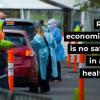Government Must Reinstate JobKeeper at Full Rate
Reactive economic policy is no safeguard in a public health crisis. From yawning gaps in the vaccination rollout to reactively cobbling together a below-poverty-line disaster payment during Victoria’s lockdown, the brunt of the Federal Government’s refusal to actively plan for public health during a pandemic has consistently fallen on those already hardest hit. As case numbers rise in New South Wales and other states remain on the alert, the Federal Government shows little attempt to meaningfully break this cycle.
The announcement last Tuesday that increased emergency payments would eventually be made available for those who lost work during lockdowns and that a joint state and federal business subsidy would be rolled out, is by its nature another iteration of a pattern of piecemeal responses – with Victorian and NSW lockdowns being demonstrably treated differently, and with little sense of what people in other states might be able to rely upon should the current outbreak spread further.
The current disaster pay system was eventually set up after Victorian Government pressure during Victoria’s May lockdown, as the premature end of JobKeeper and the temporary JobSeeker raise became painfully clear.
While on one level, any increase to this inadequate system is an improvement, the fact that these payments have been revised so quickly speaks to the reactive, haphazard way they were established, motivated by the desire to defer mounting political pressure rather than as a considered response to genuine need. It also illustrates the way in which such reactive policymaking, and refusal to undertake serious economic planning for pandemic recovery, builds in inequitable treatment.
In response, ACTU President Michele O’Neil has called for “JobKeeper 2,” a wage subsidy available for all workers as soon as a lockdown is declared at the full rate of $1500 per fortnight.
“There are huge gaps in the measures announced by the Morrison Government when they abandoned the system workers and businesses understood, JobKeeper. JobKeeper meant employers kept workers in jobs. These new schemes have very few job protections and are wide open to rorting,” O’Neil said.
A JobKeeper 2 program would keep workers linked to their employment, address economic needs more directly than the current system, and would render it a more efficient system overall. Framing an expanded wage subsidy program as a second round, not a return, would even allow Cabinet to avoid accusations of a policy U-turn. A similar approach could also help repair the damage caused by abandoning temporary safety net extensions, such as the raised JobSeeker rate, which instantly cut the poverty rate amongst recipients by over 50%. There would also be the opportunity to include carers and people with disabilities who are especially vulnerable to COVID-19 and lockdowns yet are deliberately excluded from the current disaster payment system. Extending income subsidies during a disaster makes even more sense given that under last year’s JobKeeper and JobSeeker systems, low-income earners “kept the economy moving” as they immediately reinvested their subsidies in the economy.
Most crucially, lockdowns can only be an effective public health measure if people have the means and resources to uphold them; without income subsidies, lockdowns exacerbate and further entrench patterns of inequality, which, as Sally McManus wrote on Tuesday, have only worsened over the past generation. Without income subsidies creating the conditions for more successful lockdown, they are much less likely to be effective.
This round of lockdowns was entirely predictable, given the sluggish and haphazard vaccination rollout and lack of proper quarantine facilities. They were also readily avoidable, had the choice been made to actively safeguard sufficient vaccine supply, provide clear and consistent public health information, and to simply treat vaccination as an urgent priority. Given that Australia is now in this position, the Federal Government is again faced with the question of whether to try to limit the social and economic fallout of its poor decision making or to continue pushing the burden of their failed vision onto the most strained and vulnerable members of the community.
The past weeks have been yet another reminder that precarity is not just a term used to describe a casualised and fragmented economy, but it also describes a more profound condition of our lives. The wellbeing of our society, from economic prosperity to public health, is a product of our mutual interdependence. When some groups are forced to bear the unfair burdens of system-wide failures, that injustice and harm ripples through all of us. This can make us vulnerable in some ways, but it is also a source of strength and solidarity if we choose to celebrate our interconnection and share the burden of challenges more fairly. The choice to lift the floor, so that we all are lifted with it, is as important now as it has ever been.
By Lauren Piko
australianunions.org.au

